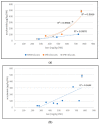Asparaginase Treatment of Sea Buckthorn Berries as an Effective Tool for Acrylamide Reduction in Nutritionally Enriched Wholegrain Wheat, Rye and Triticale Biscuits
- PMID: 37685103
- PMCID: PMC10486749
- DOI: 10.3390/foods12173170
Asparaginase Treatment of Sea Buckthorn Berries as an Effective Tool for Acrylamide Reduction in Nutritionally Enriched Wholegrain Wheat, Rye and Triticale Biscuits
Abstract
Sea buckthorn pomace is a by-product of juice production, which is still rich in bioactive compounds. After drying, the pomace can be effectively used as a valuable addition to bakery products supporting their nutritional value. However, due to the high content of the amino acid asparagine in sea buckthorn, this promising material contributes to the undesirable formation of acrylamide. To reduce the risk from this potentially carcinogenic compound, enzymatic treatment of sea buckthorn with asparaginase was applied, which resulted in a substantial reduction of asparagine content from 1834 mg/kg in untreated dried sea buckthorn pomace to 89 mg/kg in enzymatically treated dried sea buckthorn pomace. 10% substitution of wholegrain cereal flour with enzymatically treated sea buckthorn pomace powder in rye and triticale biscuits resulted in a 35% reduction in acrylamide content, in the case of wholegrain wheat biscuits up to a 64% reduction, compared to biscuits with untreated sea buckthorn pomace powder. This study confirmed that treating fruit with asparaginase is an effective way to reduce health risk caused by acrylamide in biscuits enriched with nutritionally valuable fruit pomace.
Keywords: acrylamide; asparaginase; biscuits; rye; sea buckthorn; triticale; wheat; wholegrain cereals.
Conflict of interest statement
The authors declare no conflict of interest.
Figures
Similar articles
-
Acrylamide formation in biscuits made of different wholegrain flours depending on their free asparagine content and baking conditions.Food Res Int. 2020 Jun;132:109109. doi: 10.1016/j.foodres.2020.109109. Epub 2020 Feb 19. Food Res Int. 2020. PMID: 32331630
-
Feasibility of Defatted Juice from Sea-Buckthorn Berries (Hippophae rhamnoides L.) as a Wheat Beer Enhancer.Molecules. 2022 Jun 18;27(12):3916. doi: 10.3390/molecules27123916. Molecules. 2022. PMID: 35745039 Free PMC article.
-
The Effects of Enriching Shortbread Cookies with Dried Sea Buckthorn Fruit on the Physicochemical and Sensory Properties.Molecules. 2024 Oct 31;29(21):5148. doi: 10.3390/molecules29215148. Molecules. 2024. PMID: 39519787 Free PMC article.
-
Sea Buckthorn Pretreatment, Drying, and Processing of High-Quality Products: Current Status and Trends.Foods. 2023 Nov 24;12(23):4255. doi: 10.3390/foods12234255. Foods. 2023. PMID: 38231612 Free PMC article. Review.
-
Bioactive compounds, health benefits and functional food products of sea buckthorn: a review.Crit Rev Food Sci Nutr. 2022;62(24):6761-6782. doi: 10.1080/10408398.2021.1905605. Epub 2021 Mar 30. Crit Rev Food Sci Nutr. 2022. PMID: 33783272 Review.
Cited by
-
Flavour formation in the coffee substitute 'lupin coffee' related to the formation of acrylamide.Food Chem X. 2025 Aug 16;30:102919. doi: 10.1016/j.fochx.2025.102919. eCollection 2025 Aug. Food Chem X. 2025. PMID: 40896652 Free PMC article.
References
-
- Trigo J.P., Alexandre E.M.C., Saraiva J.A., Pintado M.E. High value-added compounds from fruit and vegetable by-products—Characterization, bioactivities, and application in the development of novel food products. Crit. Rev. Food Sci. Nutr. 2020;60:1388–1416. doi: 10.1080/10408398.2019.1572588. - DOI - PubMed
-
- Quiles A., Campbell G.M., Struck S., Rohm H., Hernando I. Fiber from fruit pomace: A review of applications in cereal-based products. Food Rev. Int. 2018;34:162–181. doi: 10.1080/87559129.2016.1261299. - DOI
-
- Zhang H., Troise A.D., Sun S., Fogliano V. The water insoluble fraction from red cabbage and black currant pomace reduces the formation of acrylamide, 5-hydroxymethylfurfural and reactive aldehydes in fried potato-based crisps. LWT. 2023;173:114238. doi: 10.1016/j.lwt.2022.114238. - DOI
Grants and funding
- APVV-17-0212; SK-SRB-18-0035/Slovak Research and Development Agency
- 313011V336/European Regional Development Fund
- CA 21149 ACRYRED/European Cooperation in Science and Technology
- Contract No. 451-03-47/2023-01/200222/the Ministry of Science, Technological Development and Innovations of the Republic of Serbia
LinkOut - more resources
Full Text Sources


